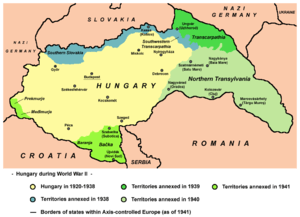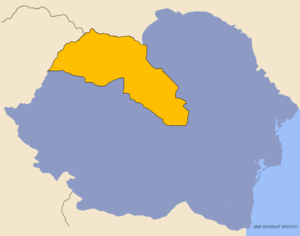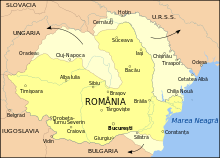Northern Transylvania
| Eastern and Transylvanian territories re-annexed to the Hungarian Holy Crown A Magyar Szent Koronához visszacsatolt keleti és erdélyi terület[1] | ||||||
| Annexed territory of Hungary | ||||||
| ||||||
| ||||||
 | ||||||
| Government | Military, later civil administration | |||||
| Historical era | World War II | |||||
| • | Second Vienna Award | 30 August 1940 | ||||
| • | Occupation | 5–13 September 1940 | ||||
| • | Military administration | 11 September 1940[2] | ||||
| • | Annexation | 8 October 1940[3] | ||||
| • | Civil administration | 26 November 1940[2] | ||||
| • | Battle for Transylvania | 26 August – 25 October 1944 | ||||
| • | Paris Peace Treaty | 10 February 1947 | ||||
| Area | ||||||
| • | 1940 [4] | 43,104 km2 (16,643 sq mi) | ||||
| Population | ||||||
| • | 1940 [5] | 2,577,260 | ||||
| Density | 59.8 /km2 (154.9 /sq mi) | |||||
| Political subdivisions | Counties[6] | |||||
| Today part of | | |||||
Northern Transylvania (Romanian: Transilvania de Nord, Hungarian: Észak-Erdély) was the region of the Kingdom of Romania that during World War II, as a consequence of the territorial agreement known as the Second Vienna Award, became part of the Kingdom of Hungary. With an area of 43,104 km2 (16,643 sq mi),[4] the population was largely composed of both ethnic Romanians and Hungarians. After World War II, the Paris Peace Treaties returned Northern Transylvania to Romania.
History


The region has a varied history. It was once the nucleus of the Kingdom of Dacia (82 BC–106 AD). In 106 AD the Roman Empire conquered the territory, systematically exploiting its resources. After the Roman legions withdrew in 271 AD, it was overrun by a succession of various tribes, bringing it under the control of the Carpi, Visigoths, Huns, Gepids, Avars and Slavs. From 9th to 11th century Bulgarians ruled Transylvania.
The Magyars conquered much of Central Europe at the end of the 9th century and for almost six hundred years, Transylvania had been a voivodeship in the Kingdom of Hungary. After the Battle of Mohács in 1526, and the Hungarian defeat by the Ottomans, Transylvania became a semi-independent principality (Principality of Transylvania) under native Hungarian rule but owing suzerainty to the Ottoman empire, then a province (Principality/Grand Principality of Transylvania) of the Habsburg Monarchy/Austrian Empire as being Land of the Hungarian Crown, and after 1848, again from 1867 to 1918 incorporated to the Kingdom of Hungary within the Austro-Hungarian Empire. The dual monarchy dissolved after World War I.
The ethnic Romanians, who formed the majority population of Transylvania, elected representatives who proclaimed the Union with Romania, on 1 December 1918. The Proclamation of Union of Alba Iulia was adopted by the Deputies of the Romanians from Transylvania, supported one month later by the vote of the Deputies of the Saxons from Transylvania, and in 1920 the Treaty of Trianon assigned Transylvania to the Kingdom of Romania.
In June 1940, after Romania was forced (as a consequence of Molotov–Ribbentrop Pact) to settle a claim to Soviet Union over Bessarabian and Bukovinian territories, Hungary attempted to regain Transylvania, which it had lost in World War I. Germany and Italy pressured both Hungary and Romania to resolve the situation in a bilateral agreement. The two delegation met in Turnu Severin but the negotiations failed due to a demand for a 60,000 square kilometres territory on Hungarian side and only a population exchange on Romanian side. To impede a Hungarian-Romanian war in their "hinterland", the Axis powers pressured both governments to accept their arbitration: the Second Vienna Award.
Historian Keith Hitchins (Hitchins 1994) summarizes the situation created by the award:
- Far from settling matters, the Vienna Award had exacerbated relations between Romania and Hungary. It did not solve the nationality problem by separating all Magyars from all Romanians. Some 1,150,000 to 1,300,000 Romanians, or 48 per cent to over 50 per cent of the population of the ceded territory, depending upon whose statistics are used, remained north of the new frontier, while about 500,000 Magyars (other Hungarian estimates go as high as 800,000, Romanian as low as 363,000) continued to reside in the south.
The Hungarian population was in the unusual situation of being an overwhelming majority in an area of southeastern Transylvania, deep within Romania and far from the Hungarian border, and not simply only in certain areas next to the Hungarian border as in the case of Slovakia and Vojvodina. The solution decided upon was to gouge a claw-shaped corridor through northwestern Romania, including a large Romanian-populated area, in order to incorporate this Hungarian-majority area within Hungary.
Population of Northern Transylvania, as per 1930 Romanian census:[7]

| County | Population | Romanians | Hungarians | Germans | Jews | Others |
|---|---|---|---|---|---|---|
| Bihor (only the ceded part) | 305,548 | 136,351 | 130,127 | 2,101 | 20,420 | 16,549 |
| Ciuc | 145,806 | 20,976 | 120,627 | 439 | 2,383 | 1,381 |
| Cluj (only the ceded part) | 256,651 | 141,607 | 85,284 | 2,669 | 16,057 | 11,034 |
| Maramureș | 161,575 | 93,207 | 11,174 | 3,239 | 33,828 | 20,127 |
| Mureș (only the ceded part) | 269,738 | 115,773 | 121,282 | 11,271 | 9,848 | 11,564 |
| Năsăud | 145,574 | 103,897 | 7,488 | 21,211 | 6,450 | 6,528 |
| Odorhei (only the ceded part) | 121,984 | 5,430 | 112,375 | 454 | 1,250 | 2,475 |
| Sălaj | 343,347 | 192,821 | 107,662 | 16,010 | 13,380 | 13,474 |
| Satu Mare | 294,875 | 178,523 | 74,191 | 9,530 | 23,967 | 8,664 |
| Someș | 219,355 | 169,942 | 33,870 | 351 | 10,546 | 4,646 |
| Trei Scaune (only the ceded part) | 127,769 | 17,505 | 105,834 | 760 | 707 | 2,963 |
| Târnava Mică and Târnava Mare (only the ceded parts) | 2,931 | 401 | 1,642 | 659 | 49 | 180 |
| Total Northern Transylvania | 2,395,153 | 1,176,433 | 911,556 | 68,694 | 138,885 | 99,585 |
| Procente | 100 % | 49,11 % | 38,05 % | 2,86 % | 5,79 % | 4,15 % |
.jpg)

Before the arbitration, in 1940, according to the Romanian estimates, in Northern Transylvania there were 1,304,903 Romanians (50,2%) and 978,074 (37,1%) Hungarians.[7] One year later, after the arbitration, according to the Hungarian census, the population of Northern Transylvania has dissimilar ratios, it counted 53.5% Hungarians and 39.1% Romanians.[8] Hungary held Northern Transylvania from 1940 to 1944. In 1940 ethnic disturbances between Hungarians and Romanians continued after some incidents following the entrance of the Hungarian Military, culminating in massacres at Treznea and Ip. After some ethnic Hungarians groups considered unreliable or insecure were sacked/expelled from Southern-Transylvania, the Hungarian officials also regularly expelled some Romanian groups from Northern-Transylvania. Also many Hungarian and Romanians fled or chose to opt between the two countries. There was a mass exodus; over 100,000 people on both sides of the ethnic and political borders relocated. This continued until 1944.[9]
Like Jews living in Hungary, most of the Jews in Northern Transylvania (about 150,000) were sent to concentration camps during World War II, a move that was facilitated by local military and civilians.
On March 19, 1944, following the occupation of Hungary by the Nazi Germany army through Operation Margarethe, Northern Transylvania came under German military occupation. After King Michael's Coup, Romania left the Axis and joined the Allies. Thus, the Romanian army fought Nazi Germany and its allies in Romania - regaining Northern Transylvania - and further on, in German occupied Hungary and in Slovakia and Protectorate of Bohemia and Moravia (e.g. Budapest Offensive & Siege of Budapest and Prague Offensive).
The Second Vienna Award was voided by the Allied Commission through The Armistice Agreement with Romania (September 12, 1944) whose Article 19 stipulated the following: "The Allied Governments regard the decision of the Vienna award regarding Transylvania as and void and are agreed that Transylvania the greater part thereof) should be returned to Romania, subject to confirmation at the peace settlement, and the Soviet Government agrees that Soviet forces shall take part for this purpose in joint military operations with Romania against Germany and Hungary."
The territory was occupied by the Allied forces by late October 1944.[10] However, due to the activities of Romanian paramilitary forces, the Soviets expelled the Romanian administration from Northern Transylvania in November 1944 and did not allow them to return until March 1945.[10]
The 1947 Treaty of Paris reaffirmed the borders between Romania and Hungary, as originally defined in Treaty of Trianon, 27 years earlier, thus confirming the return of Northern Transylvania to Romania.
Description

Northern Transylvania is a diverse region, both in terms of landscape and population. It contains both largely rural areas (such as Bistrița-Năsăud County [11]) as well as major cities, such as Cluj-Napoca, Oradea, Târgu Mureș, Baia Mare and Satu Mare. Centers of Hungarian culture, such as Miercurea Ciuc and Sfântu Gheorghe, are also part of the region. An important tourist destination is Maramureș County, an area known for its beautiful rural scenery, local small woodwork, including wooden churches, its craftwork industry, and its original rural architecture.
See also
- Ip massacre
- Sărmașu massacre
- Treznea massacre
- Romanian People's Tribunals
- Northern Transylvania Holocaust Memorial Museum
- Transylvania
- Magyar Autonomous Region
References
- ↑ Csilléry, Edit (2012). "Észak–Erdély polgári közigazgatása (1940–1944)" [The civil administration of Northern Transylvania (1940–1944)]. Limes: Tudományos Szemle (in Hungarian). Tatabánya: Komárom-Esztergom Megyei Önkormányzat Levéltára. 25 (2): 98.
- 1 2 Csilléry, Edit (2012). "Észak–Erdély polgári közigazgatása (1940–1944)" [The civil administration of Northern Transylvania (1940–1944)]. Limes: Tudományos Szemle (in Hungarian). Tatabánya: Komárom-Esztergom Megyei Önkormányzat Levéltára. 25 (2): 87.
- ↑ "1940. évi XXVI. törvénycikk a román uralom alól felszabadult keleti és erdélyi országrésznek a Magyar Szent Koronához visszacsatolásáról és az országgal egyesítéséről" [Law XXVI of 1940 on the reunification of the eastern and Transylvanian parts liberated from Romanian rule with the country under the Hungarian Holy Crown]. Ezer év törvényei (in Hungarian).
- 1 2 Thirring, Lajos (1940). "A visszacsatolt keleti terület. Terület és népesség." [The re-annexed eastern territory. Territory and population.]. Magyar Statisztikai Szemle (in Hungarian). Budapest: Magyar Királyi Központi Statisztikai Hivatal. 18 (8–9): 663.
- ↑ Fogarasi, Zoltán (1944). "A népesség anyanyelvi, nemzetiségi és vallási megoszlása törvényhatóságonkint 1941-ben." [Distribution of the population by mother tongue, ethnicity and religion in the municipalities of Hungary in 1941.]. Magyar Statisztikai Szemle (in Hungarian). Budapest: Magyar Királyi Központi Statisztikai Hivatal. 22 (1–3): 4.
- ↑ "A visszacsatolt keleti terület. Közigazgatás." [The re-annexed eastern territory. Administration.]. Magyar Statisztikai Szemle (in Hungarian). Budapest: Magyar Királyi Központi Statisztikai Hivatal. 18 (8–9): 660. 1940.
- 1 2 Charles Upson Clark (1941). Racial Aspects of Romania's Case. Caxton Press.
- ↑ Károly Kocsis, Eszter Kocsisné Hodosi, Ethnic Geography of the Hungarian Minorities in the Carpathian Basin, Simon Publications LLC, 1998, p. 116
- ↑ A történelem tanúi - Erdély - bevonulás 1940 p 56. - The witnesses of history - Transylvania - Entry 1940 p. 56. - ISBN 978-963-251-473-4
- 1 2 Rogers Brubaker, Nationalist Politics and Everyday Ethnicity in a Transylvanian Town, Princeton University Press, 2006, p. 80
- ↑ http://www.ecoduri.com/recensamantul-populatiei/Bistrita-Nasaud.php
External links
- Hitchins, Keith (1994), Romania: 1866-1947, Oxford History of Modern Europe, Oxford University Press.
- Map
.svg.png)
.svg.png)